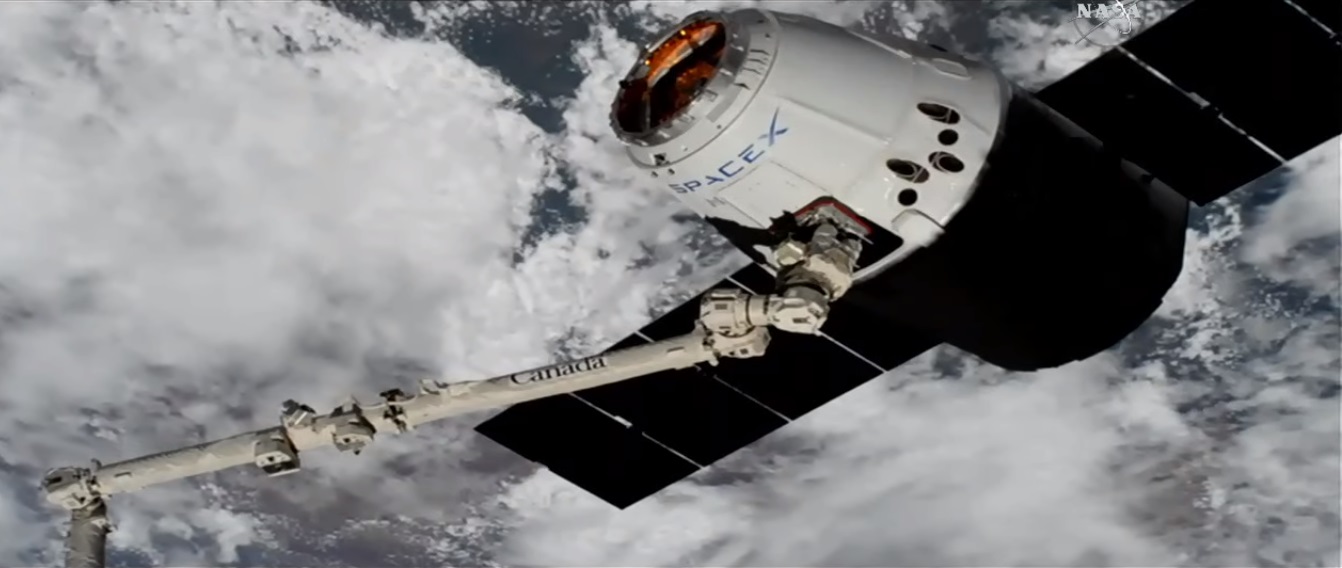SpaceX Cargo Capsule Arrives at Space Station with Tons of Supplies

A SpaceX Dragon cargo capsule carrying nearly 3 tons of supplies and science gear has arrived at the International Space Station (ISS) after a two-day orbital chase.
Astronauts aboard the ISS snagged the uncrewed Dragon today (April 4) at 6:40 a.m. EDT (1040 GMT) using the orbiting lab's huge Canadarm2 robotic arm. The cargo vehicle had launched Monday afternoon (April 2) aboard a SpaceX Falcon 9 rocket, on a contracted mission for NASA.
That liftoff initiated the second mission for both the rocket's first stage and the Dragon. The booster helped launch another SpaceX cargo mission in August 2017, and this same capsule previously visited the ISS in April 2016. Such reuse is part of SpaceX's plan to slash the cost of spaceflight, thereby opening the heavens to exploration. [How SpaceX's Dragon Space Capsule Works (Infographic)]
ISS crewmembers will soon start unloading the 5,800 lbs. (2,630 kilograms) of cargo Dragon toted up, which includes a number of scientific experiments. Among them is a study designed to help optimize plant growth in space, and an investigation into how bone marrow produces red blood cells in a microgravity environment.
Also aboard Dragon is an experimental spacecraft called RemoveDebris, which will be deployed from the ISS in the near future to test ways to clean up space junk. Once it's flying freely, the RemoveDebris mothership will practice hitting an onboard target with a harpoon, and it will also jettison a small piggyback satellite and then try to bag it up with a net.
The Dragon will remain at the ISS until next month, when crewmembers will load it up with about 3,900 lbs. (1,800 kg) of cargo from the station, SpaceX representatives have said. The capsule will depart and maneuver its way to a splashdown in the Pacific Ocean off Baja California, where SpaceX personnel will retrieve it by boat.
There was no recovery for the Falcon 9 that launched the capsule Monday, however; SpaceX did not attempt to land the first stage, because that Falcon 9 version wasn't designed to fly more than twice. The next-generation Falcon 9, known as the Block 5, will be able to launch and land at least 10 times, according to SpaceX representatives.
Breaking space news, the latest updates on rocket launches, skywatching events and more!
Dragon freighters aren't likely to see such heavy reuse, at least not in the near future.
"For the Dragon 1 cargo vehicle, we are certifying it to be capable of three full flights," Jessica Jensen, SpaceX's Dragon mission manager, said in a post-launch news conference Monday. "So, some of the Dragons are already seeing two; it will be capable of a third flight."
Follow Mike Wall on Twitter @michaeldwall and Google+. Follow us @Spacedotcom, Facebook or Google+. Originally published on Space.com.

Michael Wall is a Senior Space Writer with Space.com and joined the team in 2010. He primarily covers exoplanets, spaceflight and military space, but has been known to dabble in the space art beat. His book about the search for alien life, "Out There," was published on Nov. 13, 2018. Before becoming a science writer, Michael worked as a herpetologist and wildlife biologist. He has a Ph.D. in evolutionary biology from the University of Sydney, Australia, a bachelor's degree from the University of Arizona, and a graduate certificate in science writing from the University of California, Santa Cruz. To find out what his latest project is, you can follow Michael on Twitter.
